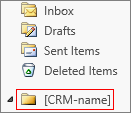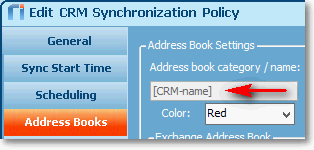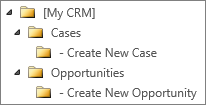|
Article ID: 1668
Last updated: 26 Aug, 2019
Contents:
Default Locations of the Folders Created by RivaThe master folderThe master folder created by Riva in an email client is inserted by default below the Inbox and other core email folders.
By default, the master folder is named after the CRM that is synced by Riva. Before the sync policy is saved for the first time ever, the master folder name can be changed on the Address Books page of the sync policy.
After the sync policy has been saved, the master folder name can no longer be changed The master folder is the parent of drop folders. The drop foldersThe drop folders are located under the master folder. There are one, two, or three different types of drop folders, depending on how the sync policy is configured.
The "- Create New Email" folder
Benefit: Copying or moving emails to this folder tracks them in the CRM. More specifically, it relates them to contacts or leads and possibly to accounts, depending on the sync policy configuration. SmartConvert folders such as "- Create New Case" Configuration scenario:
In this scenario, the default folder structure created by Riva contains folders like these:
Benefit: A Riva user can copy or move an email message to the "- Create New Case" or "- Create New Opportunity" SmartConvert folder to create a new case or opportunity in the CRM. AssignTo folders and their subfolders Configuration scenario:
In this scenario, the default folder structure created by Riva contains folders like these:
The subfolders under the Assign To folder correspond to active opportunities assigned in the CRM to the Riva user. Benefits:
Ability to Change the Folder StructureIn Riva 2.4.44.36798 or higher, the default folder structure created by Riva can be changed in the Folder Structure Editor:
Note: If a folder originally created by Riva is deleted in the Folder Structure Editor, the editor recreates the folder with its original name in its original location. Best practices:
To change the folder structure:
This article was:
Helpful |
Not helpful
Report an issue
Article ID: 1668
Last updated: 26 Aug, 2019
Revision: 14
Views: 7267
Comments: 0
|





